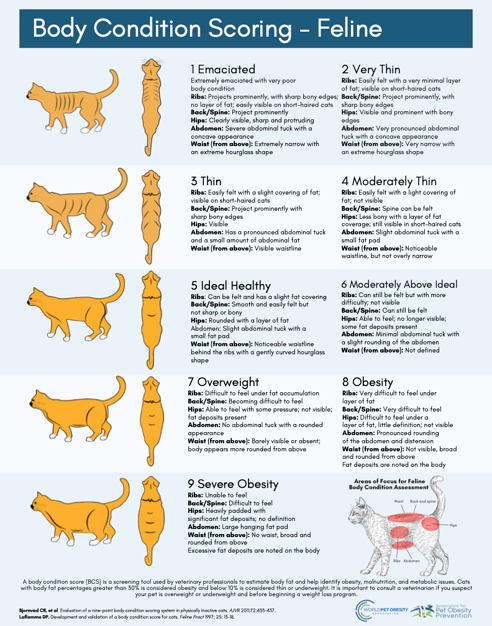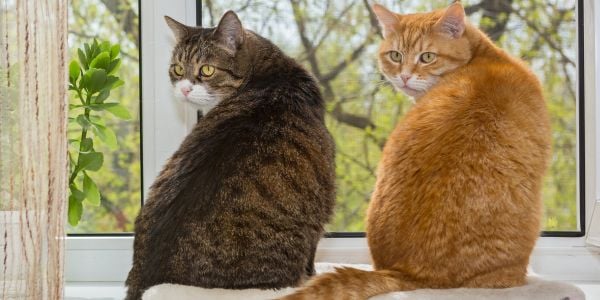
Pound by pound, inch by inch, our cats slowly ‘grow’ before our eyes, and we often don’t recognize it.
Even though there's often a lot of judgment that comes with having a chunky pet, it isn’t most pet owners’ fault for not recognizing it. Why?
Well, for one, when we see something every day, we tend to miss subtle changes.
When cats gradually gain weight, we fail to notice it because we have become acclimated slowly to how they look. And since the change isn’t instant or sudden, we fail to recognize it.
Secondly, even when we veterinarians mention your cat is overweight, there is often denial. No one wants to think of their cat as overweight or obese, especially when we know the health risks of it.
Finally, and likely the main reason, is that most cat owners don’t know what the proper weight for their cat is or how they should look. As the obesity issue in pets continues, the new ‘normal’ is a lot heavier than it once was. When we compare a ‘normal’ weight cat to an obese cat, our mind tricks us into thinking ‘normal’ is skinny and unhealthy.
Skip to section:
Is Your Cat Overweight?
I would like you to look at your cat and honestly answer these questions.
- What do you think about your pet's weight?
- Do you think that they're an appropriate weight for their size?
- Do you think they are too thin?
- Do you think they are too heavy?
- What are you basing these decisions on?
Now I would like you to look at the chart below and determine what your cat’s body condition score is. What number would you score your cat? If your cat is a 5, congratulations. But I am assuming since you are reading this article, they are likely above a 5.
Each score above 5 means that your cat has a 10 to 15% increase above their normal body weight. To make this more relatable, a domestic shorthair, longhair, or medium-hair cat that has one single excess pound is equal to 14 or 15 pounds on a 5’4” woman. Hard to believe, right?
If your cat scores above 5, they aren’t alone. According to the Association for Pet Obesity Prevention, 61% of cats and 59% of dogs (see, it isn’t just cats) in America are overweight or obese based upon results of their 2022 National Pet Obesity Awareness Day Study.
If you were shocked that your cat is overweight or obese based on their body condition score, you are among many other pet owners.
Per the APOP Pet Food, Nutrition & Weight Management survey of 2021, 45% of cat owners and 44% of dog owners DID NOT consider their pets to be overweight or obese.
Not only did such a large percentage not consider their pets overweight, 45.3% of cat owners (45.8% of dog owners) considered their pets to be ‘normal’ weight when they were, in fact, identified as being overweight or obese.
Why Is It Important to Manage Your Cat’s Weight?
I love to snuggle a ‘chunky monkey’ kitty. BUT I hate the negative impact excessive weight causes on their health.
When cats are overweight, it can cause or worsen other medical issues. This, in turn, can have significant financial and medical implications, especially in emergency situations. This translates to more debilitation and longer hospital stays for them, and more inconvenience and higher costs for you!
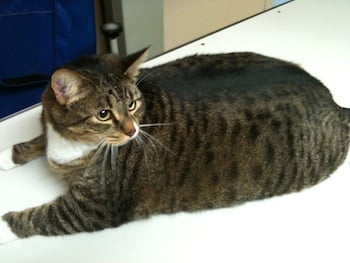 Take Dave the cat, for example...
Take Dave the cat, for example...
This poor guy is diabetic and has a tooth root abscess. The diabetes could have caused the dental infection, and the infection can make the diabetes more difficult to regulate and control.
Further complicating the problem is the concern that if Dave ever goes off his food (even if just for 24 hours), he will likely develop an emergency condition called Hepatic Lipidosis (fatty liver disease). All of this is caused or worsened by his obesity.
Illnesses and Emergencies That Are More Likely in Overweight Cats
Pancreatitis
Meaning 'inflammation of the pancreas,' this disease often results in decreased energy and appetite, with concurrent vomiting and diarrhea. While pancreatitis in cats can be fairly mild, it can also be much more severe and can be fatal (due to the triggering of a body-wide inflammatory cascade set off by the pancreatic inflammation). Overweight pets are not only more likely to develop pancreatitis, but they tend to suffer from the more severe form of it. Which means they will suffer from very intense pain and have a higher likelihood of dying.
Hepatic lipidosis
A condition typically associated with cats who have gone 'off' their food for a period of time and for any reason (including dental pain, stress, or any other reason).
Hepatic lipidosis results from an influx of fat into the liver, which damages the normal liver cells and prevents the liver from performing many of its vital functions. This condition is pretty much exclusive to those cats who are overweight or obese.
Diagnosis and treatment for hepatic lipidosis (and the underlying cause of their anorexia) typically require multiple days of hospitalization and usually cost hundreds to thousands of dollars.
Heat Stroke
Because of both the insulating properties of their excess fat and the additional strain excess weight puts on their joints, overweight cats are at increased risk of developing this debilitating, expensive, and (often) fatal emergency condition. Read more about heatstroke, and this condition is even worse for brachycephalic cats.
Urethral obstruction (in male cats)
Urethral obstruction is an acute emergency condition where a cat cannot urinate because of some obstruction within their urinary outflow tract (the urethra). It is always painful and always fatal without treatment.
This condition can happen in any cat, but it is most commonly seen in overweight male cats. Other predisposing factors, and the condition in general, are discussed in greater detail in our feline urethral obstruction article.
Appropriate treatment and management of urethral obstruction in cats typically require the placement of a soft, indwelling urinary catheter and a multiple-day stay in the hospital. Costs are typically in the $500 to $700 range and can go above $3,000 if surgery is needed.
Diabetes
Especially in cats, obesity can bring on the development of diabetes mellitus. This condition typically requires life-long management and frequent monitoring at your vet. To properly care for and monitor a diabetic cat, you can expect to pay $700 to $1,200 per year (and possibly more if not well-regulated).
It also carries with it the additional risks of a severe metabolic emergency condition called diabetic ketoacidosis, recurrent urinary tract infections, and a few others. Read this article to learn more about cats and diabetes.
Arthritis
When cats are overweight, their bodies stay in a constant state of inflammation. Fat cells produce a hormone called leptin. When leptin infiltrates a joint, it creates inflammation, and it may affect the bony changes that occur with arthritis (e.g., erosion of cartilage).
The inflammation created by being overweight alters other hormones, such as cortisol and insulin. By affecting these hormones, your cat’s body is unable to properly regulate and influence the degree of pain your cat experiences. Read this article to help your cat with their arthritic pain.
Cardiopulmonary disease
Extra burden is placed on the heart, vascular system, and lungs when cats have excessive weight. The resultant heart disease, atherosclerosis (abnormal thickening and hardening of arterial walls), high blood pressure, and breathing difficulties all have a negative impact on your cat’s quality of life.
Cancer
There is an increased prevalence of certain types of cancers when cats are obese. More studies are needed to specifically understand the risks.
Oral disease
Studies indicate that oral disease is a greater risk among overweight (44.3%) or obese (42.3%) cats compared to the remainder of the adult cat population (31.5%).
Stress and Anxiety
Cats are active hunters and players. They're also nimble and need to be able to get up high and into tight hiding spots for security. Added weight impacts their mobility, makes it harder for them to seek the safety of high hiding spots, and limits how much and for how long they can hunt and play. These losses can dramatically increase their stress levels.
Extra weight can also put stress on the joints and heart. The resulting pain, discomfort, and fatigue are all stressors that can make your cat more anxious and reactive.
Excess weight, depending on the extent, can dramatically impact your cat's body structure. These changes can make positioning and handling at home or the vet more uncomfortable, leading to increased fear and stress. It can hinder your veterinarian’s ability to properly obtain blood and urine samples for diagnostic tests. This leads to further handling and discomfort.
Many overweight cats are unable to groom themselves properly. The result is an increase in skin issues and tangled, matted, and dirty fur. This often results in them having to endure the stress of being transported to be groomed but also the stress and fear from the shave-down process itself.
Being in a state of chronic stress and anxiety can lead to other health issues, such as high blood pressure, continuing the negative cycle of poor health.
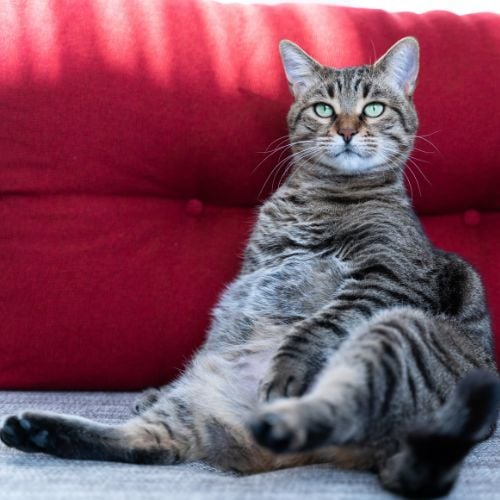
Making you aware of some of the dangers associated with your cat being overweight or obese is not meant to scare you (well, it kinda is a little bit!) but rather help you understand all the many reasons why it is so important to keep them at their ideal weight.
But how can you tell if your pet is overweight? Of course, in some pets, it's just obvious. If your cat gets stuck in the cat door or can't groom her own belly without difficulty, your cat is likely a bit too hefty. In most cases of excessive weight, though, it’s just not this obvious.
So how is one to know? I will try to help you learn how!
How to Tell if Your Cat Is at their Ideal Body Weight?
To accurately determine your cat’s ideal weight, you need to seek help from your veterinarian. They can assess your cat and determine what their body condition score (BCS) is. From there, they can show you what ‘body markers’ to use to continue to assess your cat’s body condition at home and help you recognize what your cat should look like at their ideal weight.
When vets are evaluating your pet's BCS, we look primarily at the waist, ribs, and any fat deposits on the back or near the base of the tail.
- Your pet should have a discernible waist. That is to say, when viewed from the side, your pet's abdomen should 'tuck up' as it approaches the back legs. When viewed from above, there should be a clear delineation between the back half and the front. Think of an hourglass shape. If your cat looks like a fluffy pillow or is shaped like a marshmallow to you, your cat is overweight – and potentially obese.
- You should be able to feel the ribs easily without having to press through too thick a layer of fat. If there is an excessive fat cover over the ribs, your cat is overweight.
- Your pet's back should not be perfectly flat, and there certainly shouldn't be a large fat pad along their sides or near the base of their tail. 'Love handles' are a dead giveaway for obesity in pets.
Do you remember the chart at the beginning of the article? Print it off and put it in an obvious place. Use it at home to help yourself evaluate your cat's body condition score. As you get more and more comfortable knowing what ‘normal’ is, you will be able to determine when changes occur away from what they should be.
How Can You Help Your Cat Achieve Their Ideal Body Weight?
Weight gain, very occasionally, can be due to medical disorders. Besides your veterinarian helping you determine what your cat’s ideal body weight should be, it is important to let them rule out any potential underlying medical conditions that may contribute to weight gain.
Also, at this time, they can assess your cat’s overall health and help you determine if it is safe to increase their activity levels. They likely have some tips on ways to do it too.
In some cases, achieving weight loss in our cats is typically far easier than losing weight ourselves.
This is because ... cats don't have opposable thumbs; they can't drive to the store or order online! And because of this, we have (almost) complete control over what our cats eat.
Be sure to inform the whole family of the importance of getting weight off the family pet. This way, everybody will be on the same page and can work together to accomplish the goal.
Oh, and before we get to the tips, there is one very important thing that I must point out. Based on my experiences with owners in exam rooms, the 'cup' that is referred to on the back of your cat's bag of food is not an empty yogurt container or an empty drinking cup, and it is certainly not an empty 64 oz BigGulp® cup.
It is a regular 8 oz measuring cup. This one simple change can make a huge difference in helping you achieve and maintain an ideal weight and body condition for your cat.
The line of measure on a cup is straight, not concave (don’t mound up)! Be sure to level off the cup properly so you aren’t adding extra calories by filling it over the measuring line.
To prevent overfilling, be sure to use the exact size measuring cup for how much you are to feeding. For example, if your cat gets ¼ cup of food, use a ¼ cup, not a ½ or 1-cup measuring cup.
Pro Tip: We tend to overload the cup or scoop when we are in a hurry. Cats are small animals, so a few extra kibbles or spoonfuls of wet food adds up fast. I would recommend, since most people have a busy schedule, to take the time each week and properly measure out each serving into a Ziploc® bag. This also helps eliminate measuring variations among family members.
To be even more accurate, you can actually measure your cat’s food using a food scale. This is helpful because numbers don’t lie (unless they are on my weight scale), and it will eliminate the worry about measuring exactly in a cup.
Ok, now the tips. They fall roughly into two categories – the same as with people. You’ll want, with your veterinarian’s guidance, to reduce your pet’s calorie intake and increase your cat’s activity level (i.e., their caloric burn).
Decrease Your Cat's Calorie Intake
Reduce Treats
Treats are typically the single biggest source of excess calories that most overweight pets consume on a daily basis. Your cat's treats shouldn't amount to more than 5% of their caloric intake for the day. So, if your cat should eat 350 calories (kcal) a day and you're giving your cat these Lean Treats, which are 3.1 kcal per treat, then your cat would get 5 of these treats a day, and you would reduce their regular food by 17.5 kcal. For more healthy treat options, check out our list.
Decreasing the number of treats you (and everyone else in your family) give each day and/or replacing your high-calorie treat with a lower-calorie one can save a significant number of excess calories each day.
Something as simple as breaking larger treats in half or into quarters can in and of itself save your pet 50–75% of these empty calories each day. You can try a low-calorie cat treat or give them a few pieces of a prescription dental diet instead. Speak with your veterinarian for their recommendations.
Reduce Table Scraps
Don't feed your cat table scraps (for so many reasons): toxicities, pancreatitis, and more.
Decrease Food
Decrease the quantity of food you are feeding your cat, or, if necessary, change the type of food you are feeding them. Speak to your veterinarian to see how many calories your cat requires each day for regular maintenance, as well as how many calories they should consume each day to achieve weight loss, helping them get to their target weight.
The food your cat eats need not always be a prescription diet food. In many cats, feeding a higher protein and lower carbohydrate diet can help with achieving weight loss, but these diets aren't necessarily safe for all cats! So, speak with your veterinarian, and they'll get your cat on the right diet plan.
If you are feeding your cat a dry kibble diet and they get bored with it or become demanding when you reduce the quantity of food, try this trick.
- Measure out the volume of kibble needed for each day.
- Take 1/3 of that total and feed it for the morning meal.
- Take another 1/3 of the total and feed it for the evening meal.
- With the last 1/3, try putting it in a puzzle toy, like this Catiit food tree, and let your cat play with and snack on that throughout the day. This will not only provide the calories your cat needs, but it will also stimulate your pet’s mind and encourage activity during the day while you are gone, thereby increasing their calorie expenditures (which is the other important component of successful weight loss). Check out our article for more ideas on interactive feeders.
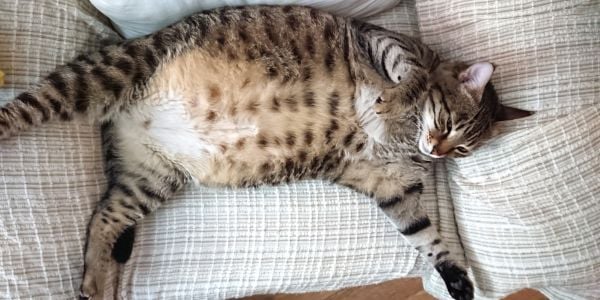
Increase the Number of Calories Your Cet Burns Each Day
Exercise!
Increase your cat’s level of daily exercise. Start slowly and gradually increase, especially with pets suffering from arthritis or other orthopedic conditions. If your cat is suffering from such a condition, be sure to speak with your veterinarian about effective and safe pain management options before starting an exercise routine.
To increase exercise for indoor cats, try indoor toys and activities.DO NOT self-prescribe and administer ANY pain medications or supplements to your cat without first speaking with your veterinarian. You can cause more significant problems than those that you are trying to help by doing so. Cats are not the same as people, and the differences in how they metabolize human analgesics can lead to costly, painful, and fatal complications. I've seen it far too often, not to mention it, so please don't do it!
Note: Be careful if you are playing with strings. Do not let them chew them, and never let them play with them unobserved (and without you holding on to one end of the string). If a cat eats string, it is likely that they will wind up on the surgery table.
Take your cat for a walk. Read this article on how to train your cat to walk on a leash.
Introducing your cat to catnip cat encourages play and movement.
Try using the prey sequence that provides even more movement, enjoyment, and mental stimulation for your cat.
Modify your cat's environment to help them be more active. Create obstacle courses to help them burn more calories as they ‘hunt’ for their food.
Create a DIY cat condo or provide cat towers that encourage them to be active in a way that doesn’t impact their joints.
Here are some cat trees that are easier to use for overweight or senior cats:
Cat Play Perch
OTLIVE Cat Tree
Nala Cat Tree
Fendrea Cat Tree
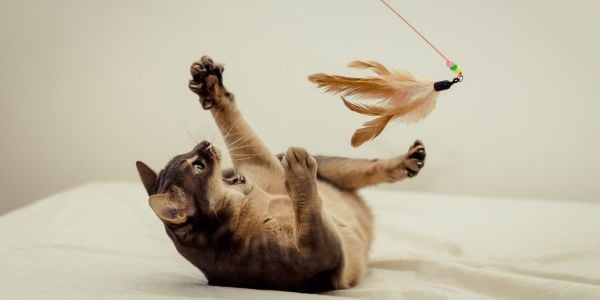
Even a couple extra minutes of increased activity each day will make a difference.
I wish you much luck and motivation on your journey to help your cat with their weight. The dangers of excessive body weight far outweigh the reasons for not getting your cat on a different eating and exercise routine. It's all up to you! Your cat really does depend on you to help them get there. If you have any questions, ask me below.



